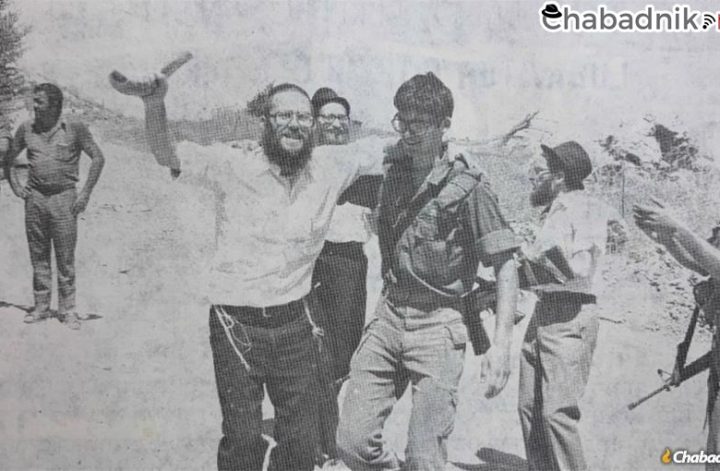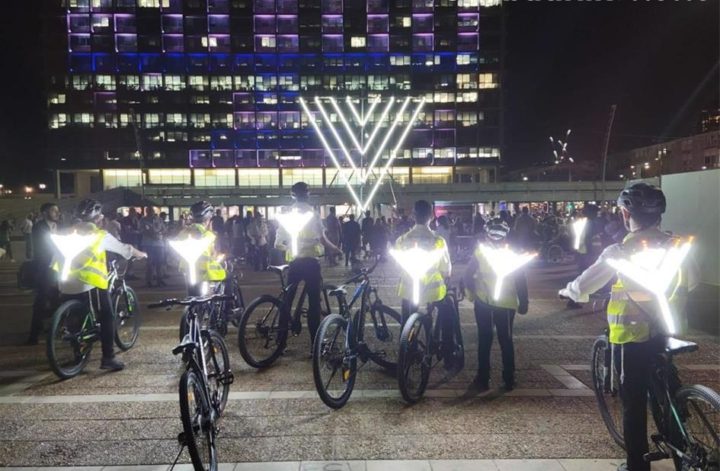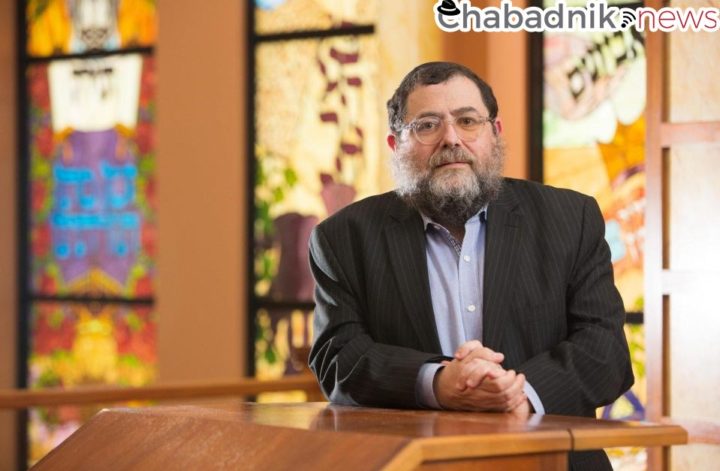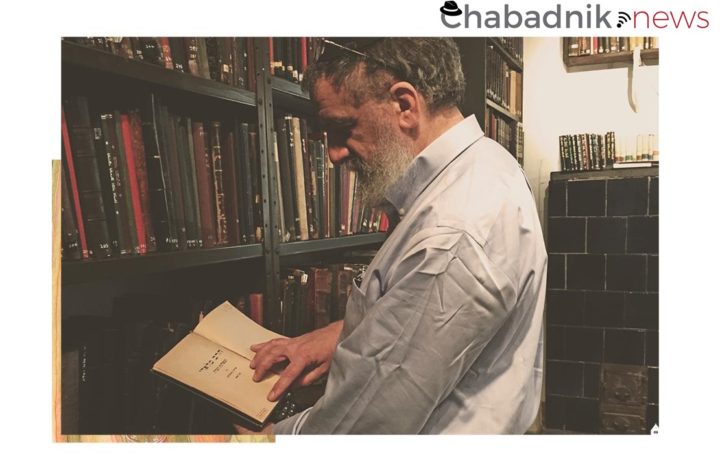The first mitzvah campaign to bring Judaism to the individual, wherever he or she was
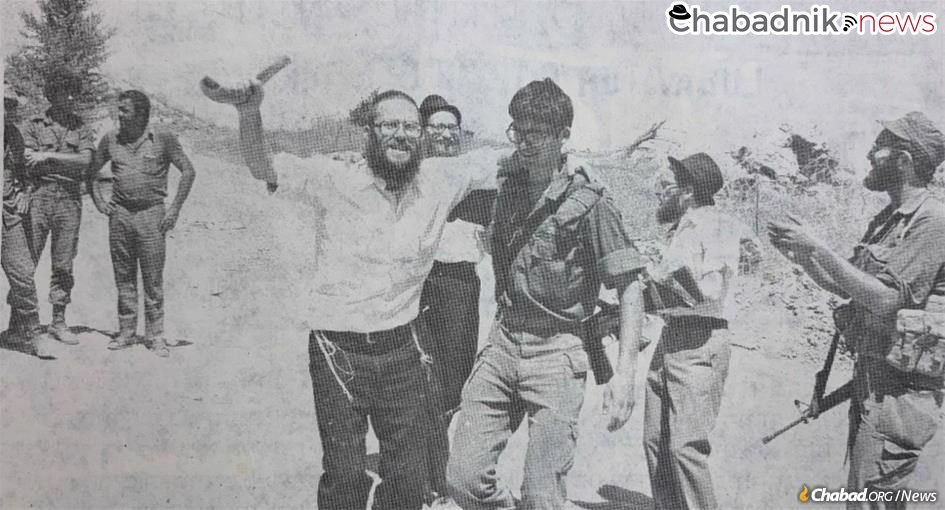
For as long as anyone can remember, the symbol of the High Holidays has been the shofar, the ancient curved instrument used to inaugurate the Jewish New Year. The shofar, most often hewn out of a ram’s horn—although it can be made out of the horns of most kosher animals—is traditionally trumpeted in the synagogue on Rosh Hashanah and is the highlight of the service. Now, with COVID-19 creating an unprecedented obstacle to synagogue attendance, many Jews around the world will still be able to hear the shofar’s hallowed cries thanks to a decades-old Chabad-Lubavitch innovation: bringing shofar to the streets.
This year, Chabad emissaries and countless volunteers are organizing more public shofar events than ever before. In Montreal, banding together under the slogan “Rosh Hashanah is not cancelled,” Chabad across the island is offering shofar at 101 different locations. In St. Louis, Chabad is hosting seven 30-minute shortened outdoor Rosh Hashanah services featuring shofar blowing. A complete directory of outdoor shofar events can be seen here.
The coronavirus and social-distancing measures it has engendered has caused the closing of an unprecedented number of synagogues, thus magnifying more than ever the need for outdoor events. Yet the truth is blowing shofar in parks—or on street corners, in hospitals, prisons, elderly-care facilities, military bases or nearly anywhere else you can think of—is nothing new for anyone influenced by the Rebbe—Rabbi Menachem M. Schneerson, of righteous memory, who launched his Shofar Campaign prior to Rosh Hashanah of 1953 (5714). At the time, there was almost no concept of bringing Judaism to the streets or wherever else Jews found themselves. Indeed, it appears the Shofar Campaign was a Chabad pilot program of sorts, a forerunner of the many mitzvah campaigns that would follow in the years to come.
From the moment that young Chabad rabbinical students hit the streets of Brooklyn, N.Y., with shofars in hand, it was clear a revolution was in the making. No one had ever seen anything like it.
“We’d go out early in the morning, before prayers, and head to the corners and the parks,” recalls Rabbi Moshe Pesach Goldman, at the time a student at the Lubavitcher yeshivah in the Crown Heights neighborhood of Brooklyn, and shortly thereafter, a young married man. Back then, the length and breadth of the borough’s Eastern Parkway was Jewish, and so it was not difficult for the enterprising young men to find ready customers. “I remember going to the big park at Eastern Parkway and Rochester Avenue between 7 and 8 a.m., and it was already filled with people.”
More than six decades later, the shocked responses the yeshivah students got in those early days remain clear in Goldman’s mind: Ich hob fargessen ingantzen—“I’ve completely forgotten [about shofar]!” Goldman recalls one elderly Jewish man telling them. Vos vilstu fun unz? Mir zeinen alte mentshen, gei tzu di yungere!—“What do you want from us? We’re old men, go to the young ones!” said another. “We told them ‘No, you’re not too old to hear the shofar!’ We asked them to repeat the blessing, and they did.”
They didn’t only approach Jews lounging on parkway benches or in the parks. The emphasis of the campaign was to blow shofar for anyone who would not otherwise have the ability to hear it, so the area’s many hospitals were likewise on the itinerary. Goldman recalls heading to St. John’s Hospital (which later merged with Brooklyn Jewish Hospital to form Interfaith) and Kings County Hospital.
“This was something totally new,” he explains. “Shofar in the street? It was unheard of.”
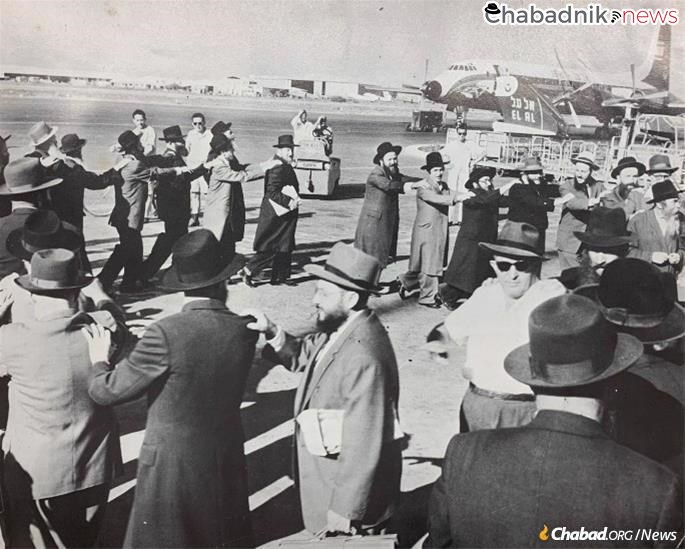
Crown Heights was at the time an upper-middle class Jewish neighborhood, and so most Chassidim could not afford to live there, instead living down the parkway in Brownsville. “When we still lived in Brownsville, we’d walk down Pitkin Avenue on our way to the Rebbe’s shul or back home in the afternoon, and all of these Jewish stores were open, and we’d walk in and blow shofar for the shopkeepers,” recalls Goldman.
The idea of bringing the spiritual and emotional highpoint of Rosh Hashanah to every single Jew was simple yet profound. In a way, not much has changed in the decades since the Shofar Campaign was initiated.
“It was very much similar to what it looks like today,” observes Rabbi Yehuda Krinsky, a Boston native at the time studying at the Lubavitcher yeshivah. Like Goldman, Krinsky remembers blowing shofar in the street, parks and in hospitals, recalling in particular visiting a Jewish old-age home that once stood on the corner of Rogers Avenue and Eastern Parkway. “There were fewer yeshivah students and not nearly as many Chabad emissaries in the field, but otherwise there was nothing different.”
Krinsky, who not long after his marriage in 1957 began serving in the Rebbe’s secretariat and is today chairman of Merkos L’Inyonei Chinuch and Machne Israel—the educational and social services arms of the Lubavitch movement—notes that he and his fellow Chabad yeshivah students already had some experience with this sort of work. Programs geared at Jewish public school students such as Mesibos Shabbos and Released Time had been pioneered in the 1940s by the Sixth Rebbe—Rabbi Yosef Yitzchak Schneersohn, of righteous memory—and Krinsky had taken part in those. Still, shofar in the street was new. “This, as well as offering passersby the opportunity to make a blessing on a lulav and etrog, was clearly an innovation of the Rebbe’s,” he says.
In response to a September 1958 letter from a Jewish hospital chaplain in Brooklyn thanking him for sending students to blow shofar for patients on both days of Rosh Hashanah, the Rebbe explained that one of the aspects of the shofar on Rosh Hashanah was to coronate G‑d Almighty as king of the universe. Just as an earthly king is more magnanimous on his coronation day, G‑d, the essence and source of all good, would surely grant all that was required for “the benefit of the health of the body and soul of all those who find themselves in the hospital in which you serve, amongst the entire Jewish people … . ”
The goal was to afford every single Jew—man, woman and child—the opportunity to hear the piercing call of the shofar, a prelude to the day prophesied by Isaiah when the “great shofar shall be sounded” with the coming of Moshiach. At the same time, the Rebbe stressed the simple healing that it brought those languishing in hospitals. Experience had shown, he said in 1978, that blowing shofar for patients “literally revives souls.”
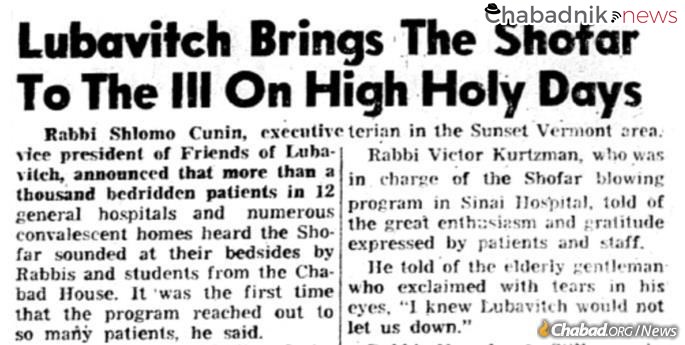
Visitors From Abroad Take to the Streets
Beginning in the late 1950s and then growing over the years, guests from around the world and especially from Israel would travel to New York to spend the month of Jewish holidays with the Rebbe. Heading out in the early morning before prayers or in the afternoon to blow shofar soon became a basic aspect of Rosh Hashanah in Brooklyn, and people started to take notice.
“A planeload of Lubavitcher Hassidic pilgrims, who arrived from Israel before the Rosh Hashana holidays to spend the Holy Days period with their Rebbe at 770 Eastern Parkway, will remain in New York for a month and depart after Simhat Torah,” reported the National Jewish Post & Opinion in October of 1960. “The full-bearded pilgrims, many of whom are farmers in the Lubavitcher cooperative ‘Kfar Chabad,’ are rich in … zeal. Starting on the Rosh Hashana holidays, they, along with local Hassidim, trek to all hospital within walking distance of their synagogue and blow the shofar for bedridden patients.”
The Rosh Hashanah efforts in Brooklyn had initially been run informally, but with the founding of the Lubavitch Youth Organization of New York in 1955—of which Goldman became secretary and on whose board he remains—the local Shofar Campaign, as well as street-side lulav and etrog project, came under its aegis. Rabbis Berel Junik and Eli Gross became responsible for both the shofar, and lulav and etrog “routes,” each year sending more and more Chassidim out to further and further locations.
Each year detailed reports of these activities would be written up and delivered to the Rebbe, who would go over them very closely.
Incubated in Brooklyn, the Shofar Campaign was brought back to the central cities and distant kibbutzim of Israel. It also followed Chabad emissaries out to the locations they were being sent—places like Miami Beach, Detroit and Milan. Chabad took California by storm in the 1960s, and by the beginning of the next decade, its young pioneer emissaries and their volunteers were bringing the Shofar Campaign to 15 hospitals—from Cedars of Lebanon and Mount Sinai (at the time two separate hospitals) in Los Angeles to St. Johns in Santa Monica, to facilities in Long Beach in the south and Berkeley way up north.
“Last year’s program was a phenomenal success,” Rabbi Shlomo Cunin, founding director of Chabad of California, told the Bnai Brith Messenger in 1971. “We have received hundreds of letters from bed ridden patients and their families thanking us for making available to them the shofar blowing … The shofar, which ushers in the New Year for the Jews, has historically brought hope and inspiration for brighter things to come in the future.”
Those on the street seemed to respond as well.
“Strolling along a street in the Park Slope section of Brooklyn, I saw a young man with a shy, fish-out-of-water look about him,” wrote Ellie Spielberg to The New York Times’s Metropolitan Diary in 1994. “ … He stopped and asked if I’d heard the shofar being blown that day. I answered no and my disappointment … .
“So he opened his jacket, whisked out a small ram’s horn … and gave me a private concert. With joyful abandon, he played and played, conjuring trills, stops and drones of a tune as old as the Bible. I closed my eyes. Then he stopped, tucked away the shofar, said ‘Shona Tovah”—Happy New Year—and was gone. It was the best Rosh ha-Shanah I’ve had.”
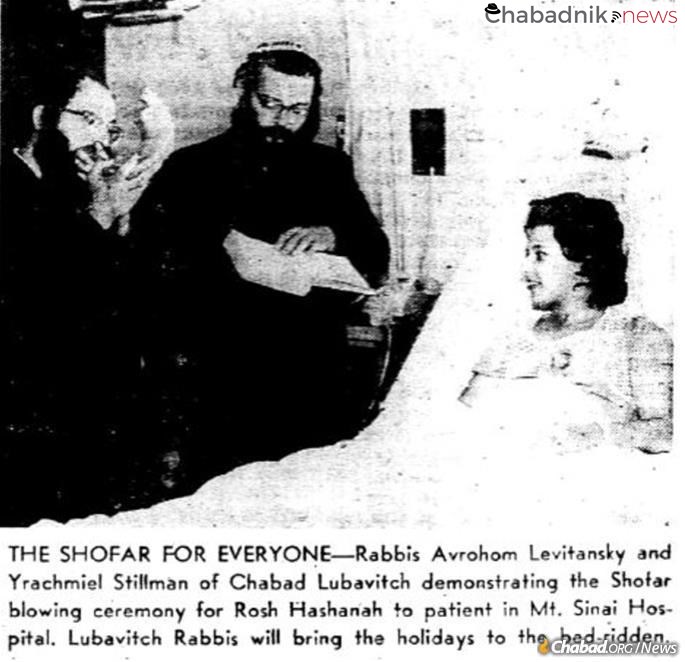
A Campaign Comes to Chicago
Like all of the Rebbe’s mitzvah campaigns, blowing shofar in public was never supposed to be solely the domain of Chabad emissaries or Chassidim, but something anybody with the right tools could do to help their fellow Jews. This was precisely the intention of Rabbi Shlomo Zalman Hecht, one of the longtime leaders of Chabad in the Chicago area, when he began drafting shofar-blowing volunteers all over the city in the 1960s. Among those he got involved were brothers-in-law Roy Pinchot and David Goldberg.
Pinchot had prayed at Hecht’s Chicago synagogue in the ’60s, but around 1967 moved to Skokie where he helped found Congregation Or Torah, the suburb’s first Orthodox synagogue.
“A year or two later, Rabbi Hecht encouraged me to organize shofar for people in the hospital,” recalls Pinchot, who now lives in Netanya, Israel. “In the beginning, I would go together with my friend Myron Jacobson, who would blow the shofar. It was quite an experience. People would break into tears.”
They would follow up with a lulav and etrog on Sukkot, and the responses Pinchot and the others received in Skokie—home at the time to one of the largest populations of Holocaust survivors in the world—were not unlike what Goldman and the yeshivah students had gotten in Brooklyn a decade or so earlier. “We would meet people who would say, ‘People still do that? I have not seen it since we left the Old Country,’ ” says Pinchot.
“For decades, I was among the group of men who would walk to the hospital on Rosh Hashanah to blow shofar for the patients,” adds Goldberg. “In time, the program was expanded to include homebound as well. I was always amazed at how many people would be eagerly hoping for us to come. By the end of the day, my lips would be drooping, but for me, it was enjoyable and rewarding.”
The program was expanded in 1982, when Lubavitch Chabad of Skokie was founded, with each congregation sending volunteers on one of the two days of Rosh Hashanah, and Chabad volunteers visiting the hospital for holidays throughout the year. This year, Chabad Rabbi Yochanan Posner has compiled a list of 22 different street corners in the town where shofar will be blown, under the auspices of the Chicago Rabbinical Council (cRc) and Lubavitch Chabad of Illinois. Ten other Chicago neighborhoods, from West Rogers Park to Lakeview, have a similarly exhaustive list of public shofar events organized by Chabad.
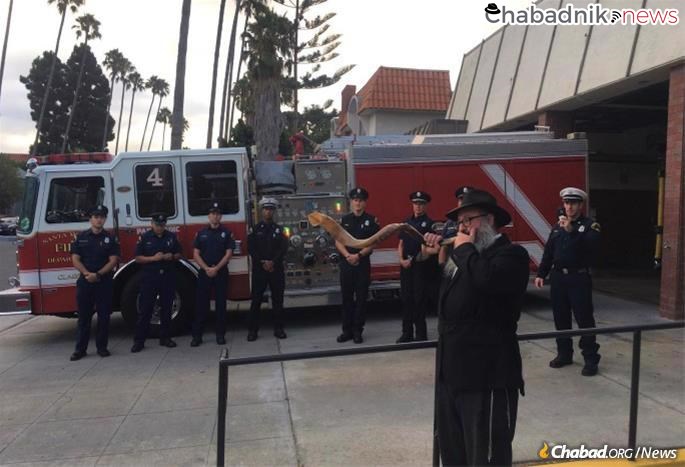
A Month-Long Campaign
In the month of Elul that preceded Rosh Hashanah 1974, the Rebbe for the first time expanded the Shofar Campaign to include the entire month, when by custom the shofar is blown each day excluding the eve of Rosh Hashanah. During this talk, the Rebbe highlighted the importance of bringing the shofar to the isolated soldiers of the Israeli military, who placed their lives on the line each and every day to protect the Jewish people, as well as Jewish soldiers in other militaries.
Over the course of the next few years, the Rebbe would continue to speak about the soldiers, but also Jews incarcerated in correctional facilities and, of course, hospitals. And so these places were added to itineraries, with prisons from New York’s storied Sing Sing to the Federal Correctional Complex at Allenwood, Pa., getting teams of dancing, shofar-tooting Chassidim during the month preceding Rosh Hashanah and the High Holiday itself.
The Rebbe continued to pay close attention to the details of the Shofar Campaign long after the Chabad movement had grown into a global juggernaut. By then, the number of guests traveling to spend the High Holidays with the Rebbe had mushroomed, yet on Rosh Hashanah of 1991, when the Shofar Campaign was announced as part of the next day’s schedule at the central Chabad synagogue, eyewitnesses recall the Rebbe turning his attention to the crowd, emphasizing his expectation that all the gathered would participate.
The cry of the shofar signifies each and every Jew’s personal acceptance of G‑d’s rule, and through this, His kingship over the entire world. True, this can be done amid the pomp and circumstance of the synagogue, but more importantly, it must occur in the hearts, minds and souls of the Jewish people, wherever they may be. For nothing quite reminds a Jew of who he or she really is like the simple blast of the shofar.
This year that will once again take place in synagogues, but also and perhaps primarily in public parks, off of porches and on intersections from Jerusalem to Moscow to Los Angeles to the streets of Brooklyn, where it all began.

